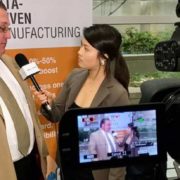Oct. 11, 2016 – At Memex, we are frequently asked questions about both the Industrial Internet of Things (IIoT) and Industry 4.0. The questions usually start off, “What do you see happening in [IIoT/Industry 4.0]?” The conversation will quickly zero in on their real concern, which is to find an answer to the question: “What and when should I be doing something with [IIoT/Industry 4.0]?”
Conceptually, are either IIoT or Industry 4.0 really new in manufacturing? The answer to that question is an emphatic “no.” One only needs to go back 36 years to the Manufacturing Automation Protocol (MAP) effort led by GM to see just one standardization attempt applied to manufacturing. For either to be successful, they must provide a net bottom line benefit for the dollars invested by delivering tangible and measurable business outcome(s).At Memex, we would argue what is changing even faster is that manufacturing is catching up, and even surpassing, other industries in truly understanding what is happening on the plant floor. Only two to four per cent of all shops or plants are monitored, a fact Dave Edstrom, Memex CTO, picked up when surveying the industry during his time as president and chairman of the board of the MTConnect Institute. When asked, most plant or shop managers will state their plant utilization is in the 65 to 75 per cent range. When hardware/software is deployed that can properly quantify this number, it is shown time and again to be actually 25 to 32 per cent. A significant inflection point for both IIoT and Industry 4.0 is MTConnect. A fact that cannot be overstated is that the open and royalty-free manufacturing interconnectivity standard MTConnect has been a huge enabler for manufacturing and provides the viable highway for information sharing from the shop floor to the top floor.
The evolution
Industry 4.0 first came to life in 2011. The name Industry 4.0 represents the fourth industrial revolution, with steam power being the first, mass production using electricity being the second, and digital computing being the third revolution for improving manufacturing. It is interesting to note in 1966, Karl Steinbuch, a German computer scientist, stated, “In a few decades’ time, computers will be interwoven into almost every industrial product.”
Industry 4.0 recognizes there are significant technical challenges that all come into play and the only way to address those are with a comprehensive framework. A key paper for Industry 4.0 is the Working Paper No. 01/2015, titled Design Principles for Industrie 4.0 Scenarios: A Literature Review by Mario Hermann, Tobias Pentek, and Boris Otto. In this paper, they bring out key design principles for Industry 4.0:
• Interoperability
• Virtualization
• Decentralization
• Real-time capability
• Service orientation
• Modularity
Interoperability is listed as the first design principle and this is where a standard, such as MTConnect, becomes critically important. While MTConnect is not yet part of Industry 4.0, there are conversations going on at very high levels. This fact was stated by Prof. Dr.- Ing. Dr. h.c. Detlef Zühlke when he sat on an Industry 4.0 panel with Dave Edstrom, Memex CTO, at McMaster University this past April.
GE is credited with coining the term IIoT, while Cisco is credited with coining the term IoT. By adding Industrial to Internet of Things, how does GE differentiate the two? We find the following on the GE Digital blog: “In today’s ever-changing and volatile market, manufacturers seek a single version of the truth that will help them make the right decisions for improving profitability, while at the same time mitigating risk as much as possible. They wish to grow their profits and their organization, while ensuring safety for employees, the general public and the environment. To obtain all of this, they need increased visibility and better insights into the performance of their equipment and assets.”
GE is positioning IIoT brilliantly in its commercials. In one, “Owen” is given a hammer by his father and is told it was his grandfathers. Owen’s father asks Owen to pick it up. Owen tells his parents that while GE builds industrial equipment, he will be writing software that will allow machines to speak to each other. These commercials are laying the groundwork for data-driven manufacturing.
Taking advantage of the platform
Now that we have provided the definitions directly from the sources and the relevant context, let’s look at how we would respond to the next question, “What does Memex see happening in [IIoT/Industry 4.0]?” For many, IIoT means that after a plant has attached all of their manufacturing equipment, they come to the conclusion that data analysis begets more data analysis and they want to start adding sensors — everywhere. These sensors include coolant, vibration, temperature, humidity, motion, current and amperage, to name just a few. These sensors come into play after shops have electronically connected to their major assets, such as machine tools and operators. This attention on connecting everything in manufacturing underscores the importance of interoperability, the first design principle of Industry 4.0.
What both of these efforts are trying to establish is to be the platform for manufacturing. What is a platform? Microsoft Windows, Apple’s iOS, Google’s Android and Apple’s OS X are all examples of platforms. A platform is not just the operating system, but it is also the rules of the road in terms of interoperability between systems, security, licensing, interfaces, reference implementations, working groups and countless other critical aspects of a platform. Building a platform that becomes an industry standard is extremely difficult and expensive.
What should a shop owner or plant manager being doing today with either IIoT or Industry 4.0?
The tremendous interest in both Industry 4.0 and IIoT are proving the point that many of us in manufacturing have known for years manufacturing is ripe for analytics. Both Industry 4.0 and IIoT fall into the data-driven manufacturing camp. Woody Allen once said, “If you live in a country run by a committee, make sure you are on the committee.” Your level of involvement today with these efforts should directly reflect the possible outcomes and the tangible net business benefits to your business. If you are running a large plant with many software developers, you might want to invest some of a software developer’s time into either investigating these efforts or possibly joining Industry 4.0.
What steps should a plant manager take with either IIoT or Industry 4.0?
• Realize these efforts are a means to an end, not an end in itself.
• The bottom line with any effort in manufacturing should answer the fundamental question, “How does this help me improve my efficiency so I can make more parts and more profits with less resources in less time?”
• Far and away, the best investment of time is to truly understand what is happening on your plant floor. The way to accomplish this is with a shop floor monitoring system. The ROI of shop floor monitoring is measured in weeks and months, delivering an average of 300 per cent Internal Return Rate of capital — the percentage is based on the information we track from our customers.
• When it comes time to connect your assets on your shop floor, use MTConnect as the interconnectivity standard.
• If you are one of the less than five per cent who have completely connected your plant floor and can see exactly what is happening on any given manufacturing asset at anytime and from anywhere, then you should start looking into where it makes sense to work with Industry 4.0.
In our opinion, IIoT for manufacturing is really about adding sensors to manufacturing and the basic challenge is interoperability; interoperability is always the challenge in computers.
Will IIoT or Industry 4.0 be the MAP of the 21st century and end up in the graveyard of industrial standards initiatives that promised much but didn’t deliver, or will both truly be worthy of the term “revolution?” Only time will tell, but our bet is it doesn’t matter what you call it, if you are not connecting your plant’s assets to be monitored, then it is not if you will go out of business, but when.
David McPhail is the CEO and president of Memex, and a current member of Manufacturing AUTOMATION’s editorial advisory board. He has chaired several working groups of U.S.-based MTConnect Institute. Dave Edstrom is the CTO for Memex, as well as the former president and chairman of the board for the MTConnect Institute. Based in Burlington, Ont., Memex is the global leader of M2M manufacturing productivity solutions. Its connectivity technologies bridge the shop floor to the top floor and provide machine efficiencies, maintenance savings, and eradicate productivity gaps.
This article was originally published in the September 2016 issue of Manufacturing AUTOMATION





